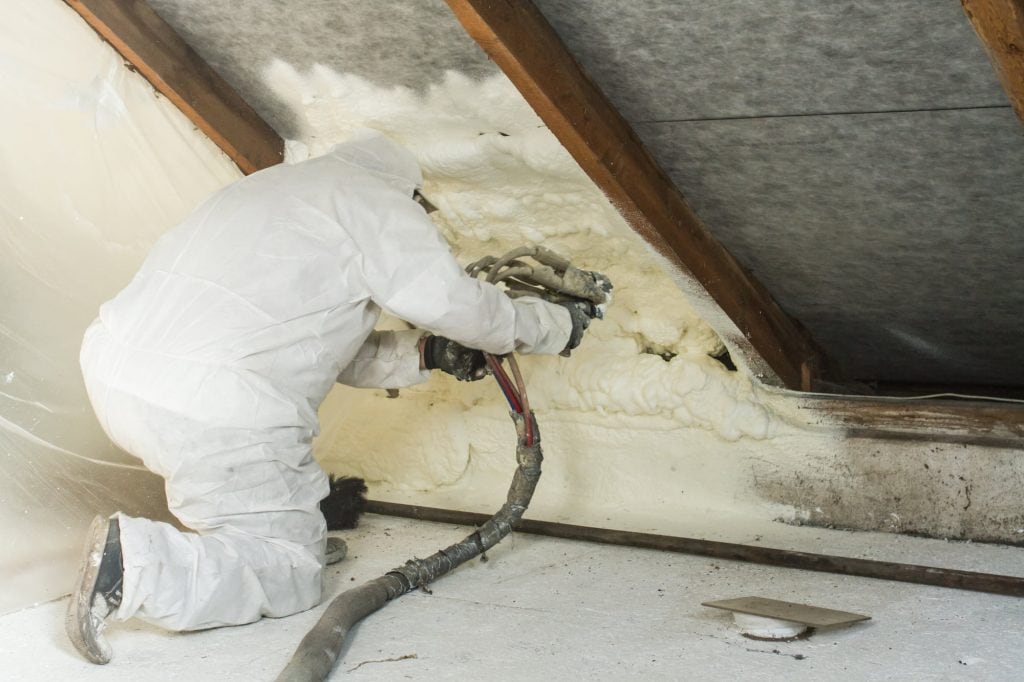Your attic plays a vital role in maintaining your home’s energy efficiency, and a key component of this role is attic insulation. When adequately insulated, your attic can help manage your home’s temperature, keeping it comfortable while reducing energy costs.
We understand how important it is to have an energy-efficient home and provide you with a comprehensive guide to attic insulation. We select the best materials for your attic and expertly install them so that you can benefit from improved energy efficiency.
Keep reading to learn more about attic insulation, as well as some tips on selecting and installing it correctly.
Understanding Attic Insulation
Attic insulation is the barrier installed in your attic space to reduce heat transfer, thus significantly preserving your home’s thermal envelope. This thermal envelope refers to the shell of your home that helps control the indoor climate, separating the conditioned interior from the unconditioned exterior. It’s all about reducing the heat that escapes from your home during cold climates and, conversely, limiting the heat that enters during warmer months.
Various types of insulation products are available, each with unique properties, costs, and installation processes. The most common types of insulation include:
- Fiberglass batt insulation
- Loose-fill or blown-in insulation, which can be made from fiberglass (fiberglass insulation), cellulose, or mineral wool.
- Spray foam insulation.

Fiberglass batts are a common type of insulation often used in new construction projects, fitted between exterior wall cavities and ceiling joists. Loose-fill or blown-in insulation, made from fiberglass or cellulose, is typically used in attics and other tight spaces.
The insulation is blown into place using special equipment. Spray foam insulation, a more modern solution, provides both an air barrier and insulation, helping to seal cracks and gaps where air may leak.
Financial Benefits and Comfort
A properly insulated attic contributes to energy efficiency by helping to manage heat transfer, reducing energy bills. According to the U.S. Department of Energy, homeowners can save up to 15% on heating and cooling costs if theri homes have proper insulation.
Besides the financial benefits, properly insulating your home also results in a more comfortable living environment. By minimizing heat transfer, insulation keeps your home warmer in the winter and cooler in the summer, reducing uncomfortable drafts and temperature fluctuations.
This is especially true in homes where the attic is used as a living space or where the roof forms part of the living space, such as in homes with vaulted ceilings or cathedral ceilings. Roof insulation prevents heat loss through the roof and helps maintain a consistent temperature within the house, regardless of outside weather.
Moisture Problems Prevention
In addition, proper attic insulation also aids in preventing moisture problems. This is where the importance of vapor barriers comes in. A vapor barrier is a material that resists the passage of water vapor, installed to protect the home from potential moisture damage. When installed on the warm side of the insulation, it can help prevent warm, moist air from seeping into the insulation and condensing into water.
A vapor barrier’s location depends on your climate. In cold climates, it’s typically installed toward the home’s interior, while in humid and warmer climates, it’s placed on the exterior. In mixed climates, a professional insulation contractor can guide you on the best placement to manage moisture effectively.
From managing heat loss and gain to enhancing your home’s energy efficiency and reducing energy bills, the benefits of effective attic insulation are immense. It’s important to understand your home’s current insulation levels and consider whether it might be time for an upgrade. Consult with an insulation expert or a local eXp agent to get personalized advice based on your specific needs and location.
Assessing Your Attic’s Insulation Needs
When it comes to attic insulation, it’s important to assess the current condition and efficiency of the existing setup. This assessment will give you a clearer understanding of whether your attic insulation needs upgrading or additional insulation is required.
Start by checking the insulation’s depth. Generally, you would want an insulation level of at least R-38 (about 12 to 15 inches, depending on the insulation type). Use a ruler to measure the thickness of the insulation and compare it to recommended levels for your climate and type of insulation.
Additionally, check the insulation’s condition. If it’s damaged, damp, or infested with pests, it will not perform effectively and should be replaced.
Look for signs of uneven insulation. Gaps, air leaks, and insufficient coverage are common insulation issues affecting your home’s energy efficiency. Also, inspect for any signs of moisture, as this can indicate a lack of vapor barrier or other underlying issues.
A home energy audit can be extremely beneficial in accurately determining your home’s insulation needs. This involves thoroughly assessing your home’s energy use and identifying areas where improvements can be made. Professional auditors use specialized tools like infrared cameras and blower doors to identify hard-to-spot air leaks and insufficient insulation.
Preparing for Insulation Installation
Once you’ve determined your attic’s insulation needs, the next step is to prepare for the insulation installation. Safety should be your top priority. Protective gear, including gloves, safety glasses, and a dust mask or respirator, is a must when handling insulation materials. Ensure adequate ventilation in the attic during the installation process, too.
Remove any stored items in the attic to clear the workspace. It’s also recommended to cover any belongings left in the attic with plastic sheets to protect them from insulation dust.
Before adding new insulation, it’s crucial to seal any air leaks in the attic and insulate ducts. Air leaks can undermine the performance of the insulation, while uninsulated ducts can lead to significant energy loss. If your attic has moisture issues or signs of mold or rot, these should be addressed before proceeding with insulation.
Consider using caulk or spray foam to seal smaller leaks around windows, doors, and electrical outlets, and mastic or metal-backed tape for duct leaks. Use rigid foam board or polyurethane spray foam for larger gaps and cracks.
This preparation process may involve some work, but it’s essential to ensure the effectiveness of your insulation project. Remember that when correctly installed, insulation can provide energy savings for years. As such, it might be beneficial to consult with an insulation expert to ensure the process is done properly and safely.
Installing Attic Insulation
The method of installing attic insulation varies depending on the type of insulation chosen. The most commonly used types are blanket insulation, loose-fill insulation, and spray foam insulation. Here’s how each is typically installed:

Blanket Insulation (Batts and Rolls): This type of insulation, often made of fiberglass, mineral wool, plastic fibers, or natural fibers, comes in the form of batts or rolls that are designed to fit between the widths of wall studs and attic or floor joists. To install, follow these steps:
- Unroll the batt or blanket and fit it snugly into the joist cavities.
- Be careful to cut neatly around any obstructions, such as pipes or wiring.
- Remember that compressing this insulation decreases its R-value or effectiveness, so it’s better to trim it than to stuff in too much.
Also, remember to insulate and air seal the attic access if it’s located within the conditioned space of your home. This can be a major source of heat loss if not properly addressed.
Loose-Fill Insulation (Blown-In): Often made of fiberglass, cellulose, or mineral wool, this insulation is blown or sprayed into place using special machinery, making it a great option for areas with many obstructions or hard-to-reach spots. Ensure you’re wearing adequate protection and begin blowing the insulation, starting from the farthest point of the attic and working back towards the attic hatch. Achieving an even level across the entire attic floor is critical for optimal performance.
Spray Foam Insulation: This insulation type is sprayed into a place where it expands and hardens. It’s particularly effective at sealing air leaks and small crevices, offering high thermal resistance. However, installing spray foam insulation can be more complex and requires professional assistance due to the chemicals and precision required.
Regardless of the insulation type, proper coverage is key. Insulation should cover all areas, especially around recessed light fixtures, wiring, and plumbing pipes. Be careful not to block the ventilation with insulation, as this can lead to moisture problems.
For recessed lights, use a baffle to create a barrier between the insulation and the light fixture, provided the light is rated for insulation contact. If not, keep the insulation at least three inches away from the light to prevent overheating.
Post-Insulation Tips and Maintenance
After installing attic insulation, performing a thorough check is crucial to ensure everything is in order. Inspect for any insulation gaps or areas where insulation may have settled or compressed; these areas can compromise the overall effectiveness of your insulation and should be addressed promptly.
Regular maintenance is key to keeping your attic insulation functioning at its best. It’s advisable to conduct periodic inspections, especially after significant weather events or home renovations that might affect the attic area. Look for any signs of moisture, which can damage insulation and reduce effectiveness. Similarly, pests can also wreak havoc on certain types of insulation.
Well-maintained attic insulation isn’t just good for your home’s comfort level, your wallet, and the environment.
It can contribute to a healthier indoor environment by reducing the risk of condensation and mold growth, which can trigger allergies and other health issues. It also minimizes the chances of ice dams forming on your roof in the winter, which can cause significant damage.
Proper attic insulation can lead to significant energy savings, considerably reducing your energy bills. It reduces the demand on your home’s heating and cooling systems, prolonging their lifespan and decreasing overall energy usage, making your home more environmentally friendly.
Key Takeaways
Attic insulation plays a critical role in maintaining the comfort of your home and enhancing its energy efficiency. It acts as a thermal barrier, preventing heat transfer and ensuring a consistent temperature within your living space, regardless of the weather conditions outside. However, it is important to remember that the type of insulation you choose should suit your home’s specific needs and budget.
A well-insulated attic is an investment that can pay for itself through energy savings within several years, but the upfront cost and installation process will differ depending on the insulation type. Consider these factors, along with the potential energy savings, when choosing the right insulation for your home.
Equally important is to ensure that the installation process is carried out correctly and safely, with attention to sealing air leaks, providing adequate coverage, and addressing any moisture issues.
Finally, attic insulation is not a ‘set and forget’ task. Regular maintenance and inspections are crucial to ensure its effectiveness over the long term, yielding significant energy savings and making your home more environmentally friendly.
For more information or to take the next steps toward improving your home’s insulation, an eXp Realty agent can provide professional advice and guide you. If you’re after a new home with a properly insulated attic, don’t hesitate to search for properties and find a suitable place to make your own.
Frequently Asked Questions: Attic Insulation
Here are some of the commonly asked questions to help you gain a deeper understanding of attic insulation:
What type of insulation is best for an attic?
The best type of insulation for an attic depends on the specific needs of your home. However, blown-in insulation, fiberglass batts, and spray foam are commonly used due to their high thermal performance.
Which is better attic insulation: blown or rolled?
Both have their advantages. Blown-in insulation is excellent for tight spaces and offers impressive coverage, while rolled insulation is often easier to install and can be more cost-effective.
How much does it cost to insulate an attic?
The cost varies based on the type of insulation, attic size, and labor charges. On average, homeowners can expect to spend an average cost that’s between $1,500 and $3,500.
Can you over-insulate an attic?
Over-insulating can trap excess moisture, leading to mold growth and wood rot. It’s essential to strike a balance between insulation and ventilation.
Can I insulate the attic myself?
Yes, but proper installation is key to effective insulation. If you need more clarification, consult with an insulation specialist.
How many years does blown-in insulation last?
Blown-in insulation can last 20-30 years with proper maintenance, but its lifespan depends on factors like humidity levels and pests.
Which is better: spray foam vs. blown-in insulation?
Both offer good insulation, but spray foam tends to provide better air sealing. However, it’s also more expensive.
Can you put insulation over old insulation?
Yes, you can add new insulation over old insulation unless the existing insulation is damp, moldy, or infested with pests.
How do I know if my attic has enough insulation?
If your energy bills are high or your home experiences significant temperature fluctuations, you may need more attic insulation. An energy audit can confirm this.
Where should you not put insulation in the attic?
Avoid placing insulation over attic vents or recessed lighting fixtures, as this can create a fire hazard.





